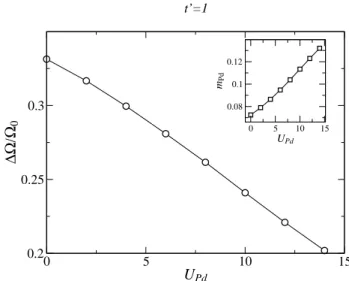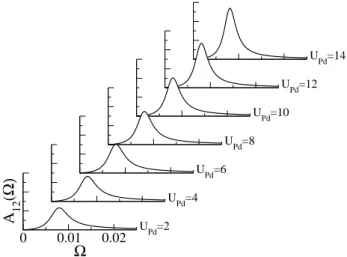848 Brazilian Journal of Physics, vol. 36, no. 3B, September, 2006
Contribution of the Spin Current to the Damping of the Magnetic Moment Precession of
Fe
Impurities in
Pd
M. V. Tovar Costa∗, A. C. de Castro Barbosa†, and A. T. Costa Jr.‡
∗Instituto de Aplicac¸˜ao, Universidade do Estado do Rio de Janeiro, 20.261-232, Rio de Janeiro, RJ, Brazil
†Instituto de Matem´atica e Estat´ıstica, Universidade do Estado do Rio de Janeiro, 20.550-013, Rio de Janeiro, RJ, Brazil
‡Departamento de Ciˆencias Exatas, Universidade Federal de Lavras, 37.200-000, Lavras, MG, Brazil
Received on 8 December, 2005
We investigate the spin dynamics of a magnetic adatom on a non-magnetic surface with strong Stoner en-hancement. We find a strong damping of the adatom’s magnetization precession and a large shift of the reso-nance frequency from its bare value. Stoner enhancement in the substrate reduces the damping. We explore the damping dependence on features of the electronic structure.
Keywords: Spin waves; Giant magnetic moment; Spin current
I. INTRODUCTION
The behavior of the Pd-based diluted alloys has attracted much attention since the first experiments indicated the ap-pereance of a giant magnetic moment surrounding the mag-netic impurities’ sites,[1]. This effect is understood as a con-sequence of the strong polarization of the host atoms by the impurity, creating a polarization cloud. Experimental results indicate that the susceptibility ofPd has a Stoner enhance-ment factor of about 10, and one can considerPd as nearly ferromagnetic. The experimental works with dilluted impu-rities ofMn,Fe andCoon Pdrevealed magnetic moments of, 8µB, 12.6µB, and 10.8µB, respectively, which corresponds extended cloud with a large number of polarized atoms [1].
The recent developments of materials’ growth and manip-ulation techniques have allowed for the fabrication of diverse nanoscopic structures. Magnetism is strongly affected by di-mensionality; thus it is expected that magnetic properties of surfaces, ultrathin films and small clusters of atoms are quite diferent from those found in bulk systems. In the case of Feimpurities or adatoms on Pd surface one expects an en-hancement of the magnetic moment due to the low coordina-tion number. Few experimental results ofFeonPd surface are reported. Bergmann using anomalous magnetic hall effect (AHE) [4] concludes that for a concentration lower than 0.3 atomic layers no magnetic moment was observed but for con-centrations above 0.5 atomic layers he found a perpendicular magnetization to the surface. Theoretical works were devel-oped to study the behavior ofFeonPdsurface. Mathon, em-ploying a single band tight-binding model [3] and including the coupling between the impurity and thePdhost, obtained as a solution an antiferromagnetic alignment betweenFe im-purity andPdsubstrate. First principle calculations were used to systematically explore the behavior of 3dand 4dimpurities onPdsurfaces. Klautau et al. [2] calculated the magnetiza-tion profile of the polarizamagnetiza-tion cloud with up to three shells of Pdatoms around theFeatom, finding strong enhancement of magnetic moment in bothFeimpurity andFeadatom inPd surface.
Although a reasonable body of work exists on the static
properties of magnetic impurities in Pd and the related polar-ization cloud, the dynamics of this kind of system is much less studied. Besides its intrinsic fundamental interest, dynamical phenomena are also very important for applications. Magnetic relaxation phenomena are specially relevant for the operation of nanoscale devices in which magnetization is switched very fast. Spin fluctuations are also expected to play a fundamental role if such devices are to work at room temperature. Thus, it is desirable to have a good account of the spin dynamics in these nanoscale systems. Here we are interested in the mech-anism of spin precession damping known as spin pumping [5, 8, 9]. It is being currently explored mainly in ultrathin magnetic films attached to non-magnetic substrates [6, 10], but of course it should be equally or more relevant to small magnetic clusters attached or embedded in non-magnetic me-dia. Theoretical studies of the spin excitation spectra of a single magnetic impurity attached to a non-magnetic metal [11] revealed a very strong damping of the spin precession accompanied by a sizeable shift of the resonance frequency, compared to the bare Zeeman splitinggµBH0. Those
calcu-lations considered, as substrates, metals for which the Stoner enhancement is negligible. If the substrate is Pd its strong Stoner enhancement should produce different dynamical be-havior.
In this work we investigate qualitatively the spin dynamics of a magnetic impurity on a substrate with strong Stoner en-hancement. We employ a simplified model for the electronic structure of the materials involved that capture the essential physics of the problem. We explore the dependence of the spin precession damping on the relevant parameters of the system.
II. MODEL
M. V. Tovar Costa et al. 849
is driven by on-site Coulomb interaction of strengthUFe. Oc-cupations of the substrate and adatom were chosen with real materials in mind:Fefor the adatom andPdfor the substrate, although we may easily vary them to investigate the effect of charge transfer. The strong Stoner enhancement ofPd is simulated by an appropriate choice of Fermi level. On-site Coulomb interactions in thePd sites are also taken in to ac-count. However, the density of states for the chosen Fermi level is not enough to satisfy the Stoner criterion.
The damping of spin motions in ferromagnetic structures can be investigated experimentally by ferromagnetic reso-nance (FMR). In a typical FMR experiment, a static uniform magnetic fieldH~0is applied to the sample, and a circularly
polarized harmonic magnetic field~h(~l,t) = (xˆ+iyˆ)h(~l)eiΩt is applied in a direction perpendicular to the magnetization. In linear response the resulting transverse magnetization in site~l is
hS+(~l)it=eiΩt
∑
~l′
χ+−(~l,~l′;Ω)~h(~l′) (1)
The susceptibilityχ(~l,~l′;Ω)above is the same whose imag-inary part gives the spectrum of spin excitations,
χ+−(~l,~l′;Ω) = Z +∞
−∞
dteiΩtn−iΘ(t)DhS+(~l;t),S−(~l′; 0)iEo.
(2) Here~l,~l′ are site coordinates,Θis the unit step function and S+(~l)(S−(~l))is the spin raising (lowering) operator at site~l. In what follows we employ a random phase approximation (RPA) to calculate the susceptibility χ+−, based on a self-consistent mean-field ground state.
To limit the complexity of the system we initially restrict the extension of the polarization cloud to the first nearest neighbor of the Fe impurity. This is done by settingUPd=0 all over the substrate except for the mentioned nearest neigh-bor.
III. RESULTS AND CONCLUSIONS
We start by showing a typical excitation spectrum in Fig. 1. The quantity we plot is All′(Ω) =ℑ{χ+−(l,l′;Ω)}; the indicesl,l′=1,2 indicate the enhanced Pd site (1) or the Fe impurity site (2). In this caset=t′=1,UFe=10,UPd=8. We chose the strength of Coulomb interaction in Fe so that Stoner criterion is satisfied at the impurity site. First principle calculations [7] indicate thatUPd ∼0.8UFe. The static field
H0is such thatΩbare0 =gµBH0=1×10−2in our energy units
(we take the substrate’s hopping integral as our energy unit). This spectrum has a lorentzian shape of appreciable width,
∆Ω/Ω0=0.26, indicating a strongly damped spin precession
[12]. Since our hamiltonian is invariant under rigid rotation of all the spins in the system, damping of local precession can olnly come from transfer of spin angular momentum from the local moment to the sea of conduction electrons. This is precisely the spin-pumping mechanism referred to in the
0 0.005 0.01 0.015 0.02 0.025
Ω
-200
-150
-100
-50
0
A
22(Ω)
FIG. 1: Local spin susceptibility in the Fe site, showing strong damping and large shift in the resonance frequency (indicated by the dashed vertical line). The dot-dashed line is the spectrum for a non-Stoner-enhanced substrate (UPd=0). Notice the larger linewidth.
0 5 10 15
UPd
0.2 0.25 0.3
∆Ω/Ω
0
t’=1
0 5 10 15
UPd
0.08 0.1 0.12
mPd
FIG. 2: Linewidth of the spectral density at the Fe site as a function ofUPd fort′=1. The inset shows the magnetization at the Stoner enhanced Pd site.
introduction. Also noticeable is the large shift in the resonance
frequency from the bare valueΩbare
0 . This can be understood
if we think of the damping as a complex self-energy added to the denominator of the spin susceptibility; the self energy’s imaginary part is responsible for the damping, its real part shifts the resonance frequency. The larger the damping larger the frequency shift.
In the same Fig. 1 we show the case of a substrate in which there is no Stoner enhancement, corresponding to
let-tingUPd=0. The increase in linewidth is small but noticeable,
indicating a larger damping. Thus, the magnetic moment in-duced in the Stoner enhanced Pd substrate serves as a “trap” for the flux of transverse spin leaking from the precessing Fe magnetic moment.
850 Brazilian Journal of Physics, vol. 36, no. 3B, September, 2006
0 0.01 0.02 Ω A 12
(
Ω)
UPd=2 UPd=4
UPd=6 UPd=8
UPd=10 U
Pd=12
UPd=14
FIG. 3: Spectral densityA12(Ω), representing the precession of the
Pd moment induced by a field applied to the Fe adatom, for a few values of the effective Coulomb interaction in the Pd site.
0.6 0.8 1 1.2 1.4 1.6 t’
0.2 0.25 0.3
∆Ω/Ω
0 0.8 1.2 1.6
t’
0.06 0.09 0.12
mPd
FIG. 4: Linewidth of the spectral density at the Fe site as a function oft′forUPd=8. The inset shows the magnetization at the Stoner enhanced Pd site.
of the electronic structure, if desired. In view of the preceding analysis, it is interesting to see how a variation of the Stoner
enhancement in Pd affects the damping of the Fe adatom’s magnetic moment. In Fig. 2 we plot the linewidth of the
spec-tral densityA22(Ω)as a function ofUPd. As the enhancement
increases the magnetic moment in the Pd site also increases, becoming a more efficient trap for the magnetic moment leak-ing from the Fe adatom; thus the dampleak-ing decreases. The
behavior ofA+−12 (Fig. 3) favors this analysis. This component
of the spectral density gives the precession amplitude induced in the Pd site by a field applied to the Fe adatom, as indi-cated by eq. 1. As the Stoner enhancement increases so does the precession amplitude at the enhanced Pd site. This cor-responds to an effective increase in the ferromagnetic part of the sample, which leads to a smaller overall damping. A sim-ilar behavior is observed in ultrathin ferromagnetic films as a
function of film thicknessN: the damping decreases roughly
as 1/N[10].
The interpretation of the damping as resulting from a flux of spin angular momentum towards the substrate suggests that
the strength of the hopping integral t′ between the adatom
and the substrate should play an important role in the de-termination of the intensity of the damping. In Fig. 4 we
plot the linewidth of the spectral density A22(Ω)as a
func-tion oft′ for fixedUPd =8. It shows the damping
decreas-ing ast′increases, contrary to what one’s intuition might
in-dicate. However, analysing the dependence of the magnetic
moment at the enhanced Pd site ont′one sees that it increases
rather strongly; as seen before, a largermPd means a more
efficient trap for the spin current emanating from the Fe site,
thus a smaller damping. In this case the increasedmPd more
than compensates for the increase in connectivity between the adatom and substrate that would facilitate the flux of spin cur-rent, thus increasing the damping.
Acknowledgments
M.V.T.C. and A.C.C.B. aknowledges the Depesq/UERJ for partial finnancial support. A.T.C. acknowledges financial sup-port from CNPq.
[1] F W. Constant, Phys. Rev.,36, 1654 (1930); G. G. Low, Proc. Phys. Soc. Lond, 89, 119 (1968); G. J. Nieuwenhuys, Adv. Phys.,24, 515 (1975).
[2] A.B. Klautau, P.R. Peduto, and S. Frotta-Pessoa, J. Magn. Magn. Mater.186, 223 (1998).
[3] M. Afisharnaderi and J. Mathon, J. Phys.12-C8, 164 (1988). [4] G. Bergmann, Phys. Rev. B23, 3805 (1981).
[5] L. Berger, Phys. Rev. B54, 9353 (1996).
[6] Y. Tserkovniaket al., Phys. Rev. Lett88, 117601 and Phys. Rev. B66, 224403 (2002).
[7] F.J. Himpsel, J. Magn. Magn. Mater.102, 261 (1991). [8] J. Slonczewski, J. Magn. Magn. Mater.102,195, L261 (1999). [9] D.L. Mills, Phys. Rev. B68, 014419 (2003).
[10] A.T. Costa, R.B. Muniz, and D.L. Mills, submitted to Phys. Rev. B.
[11] R.B. Muniz and D.L. Mills, Phys. Rev. B68, 224414 (2003). [12] For the sake of comparison, the same kind of calculation for a

